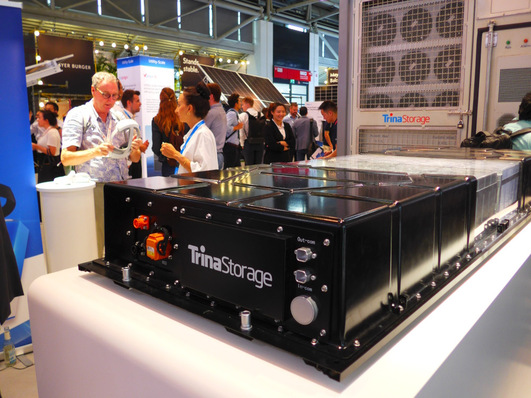Sustainable and future-oriented – the success of the energy transition depends on combining wind farms and solar installations with efficient storage systems. While these systems are responsible for quickly offsetting power fluctuations to guarantee grid stability, they also have to be able to store power so that it is available for a longer period of time. And there is plenty going on in the industry as it works toward this goal. Companies are developing pioneering products and solutions for stationary and mobile electrical energy storage systems.
Efficient storage systems for renewable energy
For example, producers of lithium-ion battery storage systems now suggest the projected service lifetime to be over 20 years – with low capacity losses and up to 20,000 charging cycles. More and more storage systems are being designed for outdoor use. Large-scale photovoltaic installations are being equipped and retrofitted with directly coupled storage solutions – offering lower systems engineering costs and minimized losses. Storage system solutions are now being used to improve grid quality for wind farms and solar parks, as well as to construct high-quality and stable stand- alone grids. The load peaks and spikes in generation are processed and smoothed with grid- compatible energy management. Increasing numbers of devices are also offering expanded emergency power and back-up functions, as well as balancing power services. And finally, electrical storage systems are becoming a key technology for e-mobility – adequate storage is vital for making the vision of a comprehensive charging infrastructure a reality.
The finalists
ads-tec Energy (Germany): One challenge for clean mobility is enabling high-speed charging for electric cars even though the grid is not designed for this. And this is where the StoraXe HPC Booster comes in. With a capacity of up to 140 kWh, this storage solution supplies high-speed charging points with a charging power of up to 320 kW. The StoraXe HPC Booster is connected to the 400 V distribution grid and recharges there at a rate of 50 kW. The device is certified for outdoor use and is also liquid-cooled.
Alpha ESS Europe GmbH (Germany): The SMILE-B3 storage solution in the Storion series is an AC-coupled compact storage system for residential use with a 2.9 kWh lithium-iron- phosphate battery storage unit and a charge and discharge capacity of 3 kW. Designed for a service life of 20 years, the storage system can complete over 10,000 cycles at a depth of discharge of 96 percent. Alpha ESS Europe offers a 10-year warranty. Rated under the protection class IP65, the 45 kilogram device is also suitable for outdoor use.
Bluestorage (France): With a capacity of between 250 and 400 kWh, the LMP (lithium metal polymer) 250/400 rack is the cornerstone of this storage solution and currently the only solid-state battery on the market. The housing contains an integrated controller, is hermetically sealed and does not require cooling. The racks can be assembled to create a storage system of up to 3.2 MWh. The LMP batteries do not contain cobalt or liquid electrolytes, and can be operated at temperatures of up to 105° Celsius. They have a service life of up to 4,000 cycles and have proven their suitability for everyday use in car sharing projects.
Chakratec (Israel): Charging electric cars at charging stations, particularly on highways, places considerable demands on electrical output. This is especially true if several charging points are used at the same time and high-speed charging is required. The Kinetic Power Booster provides an innovative, efficient and space-saving solution for this, using spinning reserves in the kinetic storage system to significantly boost the electrical output.
EET – Efficient Energy Technology GmbH (Austria): The SolMate system is a smart domestic storage solution combined with registration-free PV modules which are simply plugged in to a standard German Schuko socket. It stores power in lithium-iron-phosphate cells with a capacity of 960 Wh and has a connected load of 500 W. Storage control is based on measurements made directly at the socket using a patented method, and no further measuring elements are required. In the standard operating mode the in-built inverter is externally commutated, though it can also be used for stand-alone operation.
Enerox GmbH (Austria): The CellCube storage system is based on vanadium redox flow technology. This enables more than 20,000 charging cycles over a service life of 30 years, with virtually no degradation. And at 95 percent, the system also achieves a high level of efficiency. The scalable, high-performance 250 kW units can be used in large-scale solar parks and wind farms, as well as in self-sufficient building solutions and stand-alone grids. They can also be used to provide services in the capacity and balancing markets as well as in load and generation management.
Maschinenfabrik Reinhausen GmbH (Germany): The GRIDCON@ PCS 4W has proven itself as a modular, bi-directional inverter unit with 3 x 40 kW for storage coupling in industrial environments, during both on-grid and off-grid operation. With extremely short reaction times of under 100 milliseconds, the energy management system makes it easy to bring spikes in production from solar parks and wind farms under control. Its additional strengths lie in its wide range of options for grid management, including reactive power control, frequency regulation, elimination of harmonic distortion, and asymmetrical load compensation. This enables the device to be used to construct stable stand-alone grids for microgrid applications and convenient solutions for supplying emergency and back-up power.
SMA Solar Technology AG (Germany): Directly storing solar power in large-scale PV power plants saves money which would otherwise need to be spent on additional systems technology – and because fewer conversion steps are needed, this method of storage is more efficient. The large-scale storage systems, with direct DC coupling, are also well suited to retrofit projects in PV parks. The outdoor appliances are delivered ready to connect and have a wide MPP control range of 500 to 1500 V. Up to six devices can be connected to a central inverter unit from SMA with output of up to 3 MW.
Sol-Ark Portable Solar LLC (USA): The Sol-Ark 8K is an efficient and flexible hybrid inverter designed for 48 V battery systems, and can be used both on-grid and off-grid. The robust device with controlled ventilation supplies a power output of up to 20 kW in stand- alone systems. It can be operated with grid frequencies of 50 Hz and 60 Hz, and with lead or lithium-ion batteries. It communicates with the battery via CAN or RS 485 bus.
The ees AWARD Ceremony will take place on May 15, 2019 at The smarter E Forum in hall B3, booth B3.570 in Munich. (HCN)
Stay informed, get our free newsletter twice a week. Register here







